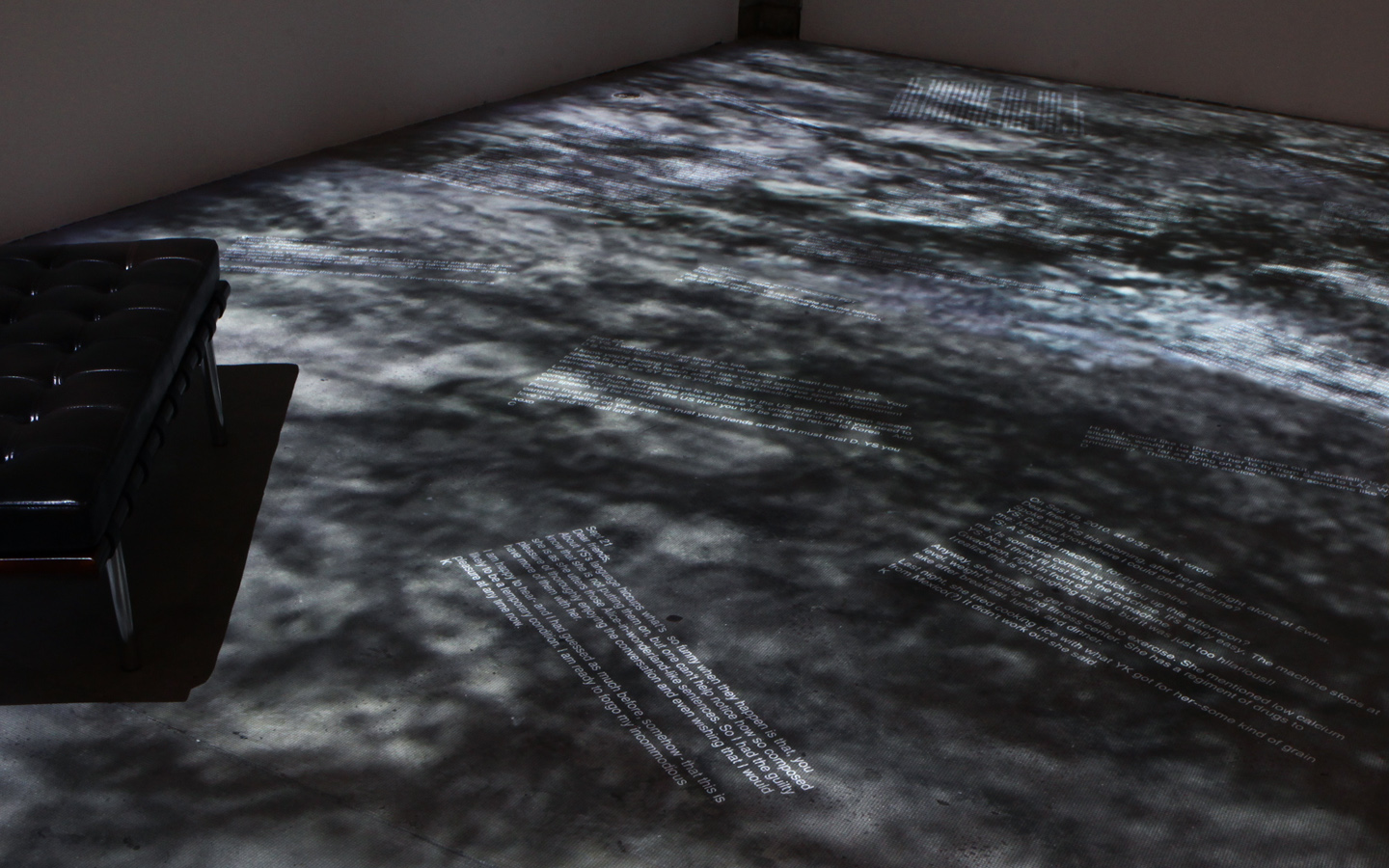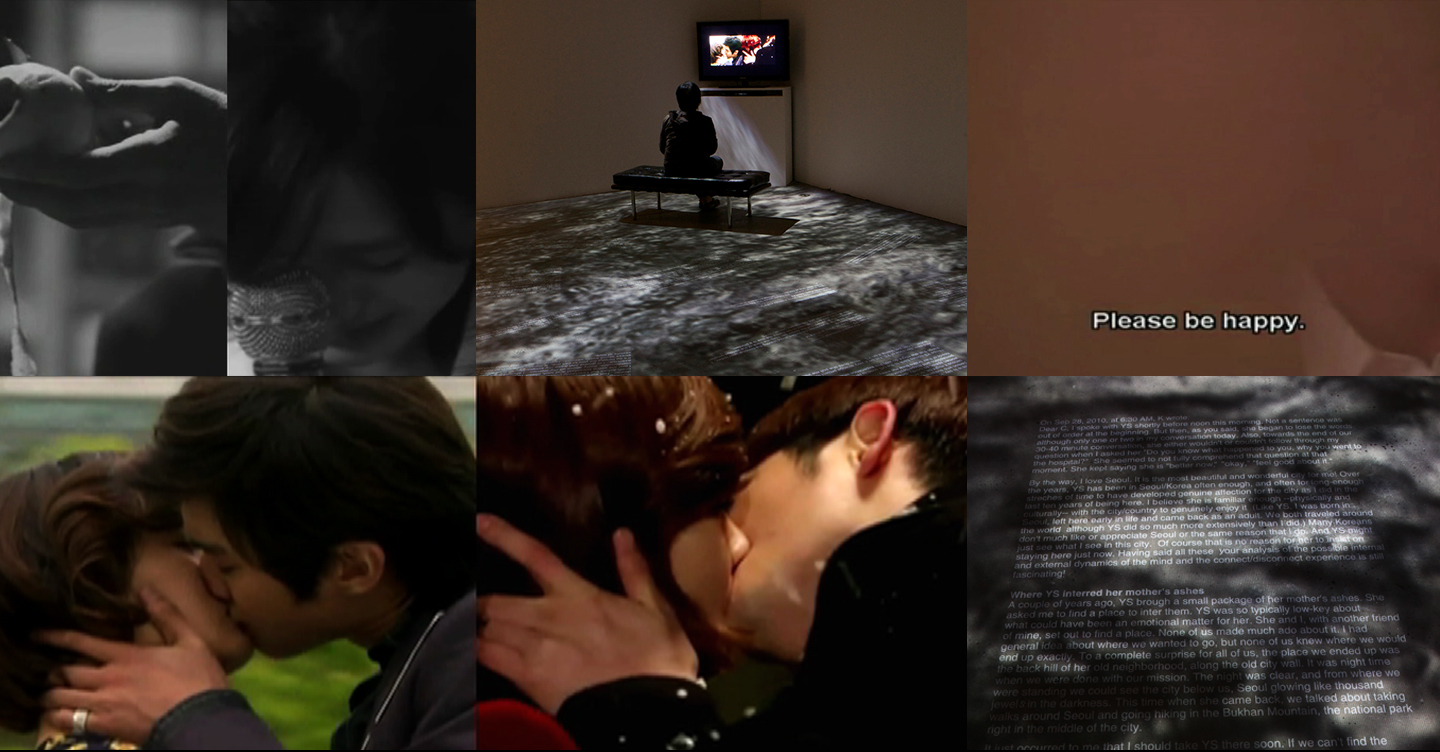
OVERSEAS / at sea, May 19 – July 3, 2011, floor projection with vinyl, COLA 2011, Los Angeles Municipal Art Gallery, CA. Exhibition catalog: http://cola2011.lamag.org/min/index.html.

OVERSEAS / at sea, detail, scenes of floor projection with bench and single channel video, TRT: 15 minutes.
For several decades, Yong Soon Min has created a body of work that ruminates on the condition of diaspora. Subjectivities shaped by the aftermath of war, colonialism and oppression frequently occur as conceptual and formal motifs. However in “Overseas/at Sea,” recent personal challenges and medical obstacles are employed by Min to create a densely layered, poetic two-part video installation juxtaposing autobiographical texts and found videos of Korean television dramas with footage of brain scans. Awash with sentimentality and longing, yet still retaining Min’s artistic strategies of disruption and distanciation, “Overseas/at Sea” responds to the turbulence and confusion Min felt after a brain hemorrhage was diagnosed in Korea in 2010.
In the installation, viewers encounter a room-sized video projection of a dark ocean that tumultuously collapses upon itself on the gallery floor. Waves are projected over a set of vinyl letters documenting an email exchange between a group of friends and the artist. The narrative details Min’s medical condition and how the brain bleed has induced a loss of recent memory and a deterioration of language. Concerned about the artist’s aphasia-like symptoms, her friends and colleagues suggest speech therapy. Min denies the problem and refuses assistance, but finally returns to Los Angeles to seek medical treatment. The narrative, like Min’s loss of language, flows in and out of visibility, animated by the dark looping waves.
Adjacent to the projection, a single-channel video remixes appropriated fragments of Korean television dramas and brain scan animations. Montaged in a seamless sequence, the videos are held together by music and a non-linear narration recited in English and Korean. Passages of dreams, childhood memories, philosophical deliberations, and conversations about happiness and finitude are coupled with kaleidoscopic imagery evocative of family, modernity, and romance. A touching moment is elicited when an altered clip from Ozu’s “Last Spring” is juxtaposed with a mournful lament about immigration and identity. By re-narrativizing videos of Korean pop melodramas with memory fragments, the autobiographical stumbles into the archive.
In one section of the video an off-screen voice reads in Korean: “Pronouns were meaningless at the beginning. There was no gravity for words, nothing to hold them to the ground. Groundless.” For Min, the hemorrhage caused language to become weightless. Free of context, words reveal their secret doppelgangers. They float, interchange, mutate into other sets of associations: “Diaspora/diarrhea, hemorrhage/hemorrhoids, pyramid/pizza, hospital/hotel, tutor/tourist, Dae Jang Geum/Dan Jang Gu, speech/spinach, cheat sheet/cheat shit, he/she, namja/yeoja.”
The autobiographical in “Overseas/At Sea” serves to give form to a narrative indicative of larger historical contexts. Troubling the idea of translation, displacement, and memory, Min’s split-use of language denies a universal address. Passages switch between Korean and English, but the doubling does not suggest equivalences. The two languages cohabit in a contrapuntal cadence of exchange, but meaning and legibility are entirely contingent upon one’s position. Duality is frequently evoked elsewhere in the video: symmetry, split-screens, mirroring effects, the here and there. Recollection and recovery. But pairs are presented merely to be broken. It is the order of the sea.
—Steven Lam